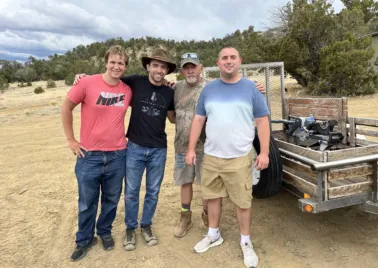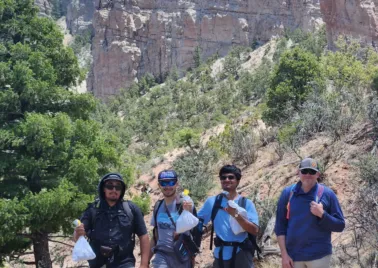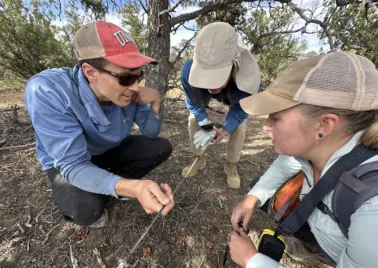
RFS Hosts Its First Citizen Scientists August 30-31, 2025
RFS hosted three young professionals who went to high school together, but…

RFS is pleased to announce the Reynolds Field Station booth at Geological Society of America Connects 2025 Conference. You can talk to RFS Directors, pick up literature, and explore opportunities to visit and participate in Field Station learning and research programs. Students and faculty who are currently conducting research at the Field Station will also be dropping by to give their first-hand views of the facilities. Come by and visit us, we’re at Booth #344!
We are proud to announce that research results of Leo Kuhl, one of the New Mexico State University graduate students who did his Master’s Degree research and mapping at RFS will be presented at the Conference. It is titled: The Provenance and Stratigraphic Record of Cordilleran Magmatic Arc Exhumation in the Lower Part of the Upper Cretaceous Crevasse Canyon Formation in West-Central New Mexico. It is part of session T34. Advances and Applications in Geochronology for Interpreting Stratigraphic and Basin Records, Part I. It will be presented on Sunday October 19, in the Henry B. Gonzalez Convention Center, Room 304C at 9:25 AM Central Time.
Brian Hampton
Kuyl, Leo1, Hampton, Brian2, Thines, Jennifer3, Contreras, Dori4
The Crevasse Canyon Formation in west-central New Mexico outcrops along the southeasternmost margin of the Colorado Plateau and records primarily fluvial sedimentation along the Seboyeta embayment during the Late Cretaceous (Coniacian-Santonian) development of the Cordilleran foreland basin. Although this stratigraphic interval has received a considerable amount of study throughout parts of northwestern New Mexico and the Southwestern U.S., very little is known about the depositional history provenance of these strata in west-central New Mexico. Throughout much of the New Mexico, the Crevasse Canyon Formation has been documented to represent nonmarine, fluvial sedimentation and marks the final stratigraphic transition from marine sedimentation to nonmarine sedimentation in the Cordilleran foreland basin.
New measured stratigraphic sections, paleocurrent data, sandstone modal composition trends, and U-Pb detrital zircon data from the lower parts of the Crevasse Canyon reveal a depositional system characterized by (1) isolated, cross-stratified channel sands encased in floodplain strata that contains fossilized leaves, stumps, woody debris, and charcolithified organic material, and (2) laterally extensive sandstone bodies that exhibit isolated, faint cross stratification. Paleocurrent indicators from sandstone units display a wide range of flow directions that include northeast, east, and dominantly southeast directed paleoflow. Sandstone modes from these strata have high relative abundances of quartz (primarily monocrystalline, followed by polycrystalline quartz and chert), outsized feldspar (plagioclase and K-Spar), and a range of lithic fragments that include isolated volcanic, metamorphic, and sedimentary lithic fragments. Plutonic lithic fragments are very common and occur in nearly all samples collected from measured sections.
U-Pb detrital zircon ages contains (1) Precambrian zircons that overlap with the Yavapai, Mazatzal, and Granite-Rhyolite, and Grenville provinces, (2) recycled Neoproterozoic and Early Paleozoic detritus from Mesozoic eolianites of the southwestern U.S., (3) Permian-Triassic zircons that overlap in age with granitoid sources of the Cordilleran magmatic arc. Elevated occurrences of Permian-Jurassic zircons coupled with widespread occurrences of plutonic lithic clasts and outsized feldspar grains indicate that this basin was receiving detritus largely from deeper, exhumed parts of the Cordilleran magmatic arc.

RFS hosted three young professionals who went to high school together, but…

The Reynold’s Field Station (RFS) hosted its first official geology field camp…

Dr. Drew Peltier a tree physiologist at the University of Nevada Las…

INTERESTED IN LEARNING MORE?
We are passionate about the sharing the amazing environment and scientific learning opportunities at the Reynolds Field Station. We encourage you to Contact Us about ways you and your institution can participate in exploring and contributing to the science and appreciation of this natural wonderland. We are a 501(c)(3) public charity and welcome donations that will enable travel expenses, grants and scientific equipment for learners who need assistance participating at the Field Station.